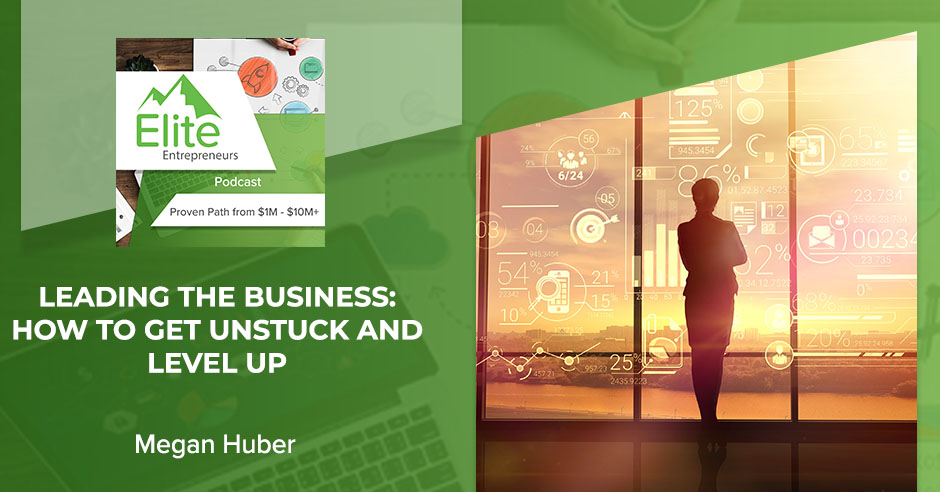Episode 127: Leading The Business: How To Get Unstuck And Level Up With Megan Huber
Watch the episode here
Listen to the podcast here
Women entrepreneurs need to start taking charge if they want to lead their businesses into the 7-figure mark. Instead of thinking that they can’t do it, they need to have the mindset to start taking action. You can get to 400 or 500K a year by yourself. But in order to reach your next goal, you cannot be the sole provider of what you’re delivering. Join Brett Gilliland as he talks to business growth strategist and coach, Megan Huber about how you can take your business to the next level. Stop being the business and start leading the business to greater heights today!
—
It has been a little while since I have had an interview. It looks like a steady stream of interviews week after week but my interviews come in batches. I’m genuinely excited to share with all of you my guest. Her name is Megan Huber. She is the Cofounder of Structured Freedom, which is a company that I’m getting excited about as I learn about it. Megan, you, your husband, and your team find ways to help people move their businesses forward and find new levels of freedom with their businesses. That’s super exciting. Please, tell us a little bit more about your business, and then we will jump into some lessons for our audience that you have to share.
Thanks for having me. I’m excited for us to geek out like we were talking about earlier on these incredible topics. My husband and I have a company, Structured Freedom. I am the Business Strategist side of our company. I primarily work with mostly women entrepreneurs who are running mid multiple 6-level businesses, even into the 7 figures. When they are transitioning into that next level, what they need to be focusing on becomes systems, processes, leadership, and team, and optimizing their client delivery and client experience. Those are the areas that I focus on with my clients so that their business is sustainable. They have processes, systems, and SOPs that are duplicatable.
We are helping them remove themselves from being the business into running the business so that they can also live a great life. We don’t want to create a business that’s reducing our quality of life. We want to run a business that is enhancing our quality of life, which is why many of us join businesses in the first place, run them, and start them. It’s for a different level of freedom and to have more choices.
You don't want to create a business that's reducing your quality of life. You want a business that's enhancing your quality of life. Click To TweetYou said several things in there that you are right. We could geek out for hours. In the time that we have, though, I’m going to grab onto something you said, we got to help them remove themselves from being the business to now leading the business, building the business. I may have butchered what you said but it was close to that. I’ve seen that. You’ve seen that. Entrepreneurs get entangled in the business itself that they have a hard time separating from it and learning how to give the business a life of its own, separate from the business owner. What have you seen in that area? How do you help people get out of that mode of being stuck in the business?
For most of us, especially if we have a business that is service-based, I work with other service-based entrepreneurs, not product-based usually. We were the business in the beginning because we were selling ourselves. Whether it is selling a consulting service, a web design service, graphic design or coaching, there’s all the rage for experts, coaches, consultants, and gurus online. Honestly, we were selling a lot of our time. Whatever service we were selling, it required our time to deliver it. You can build a great business that way. I got to about $400,000, $500,000 a year. It was predominantly me providing the service.
If you’ve got the right price points, you can manage that but you quickly realize, “I’ve positioned myself and my company that you are getting me.” The only way to get results is through me. Now your audience and you believe that. To jump from, let’s say, $400,000, $500,000 to $1 million plus, you cannot be the sole provider of what you deliver. That’s number one.

Leading The Business: You can get to $400k or $500k a year as you predominantly provide the service. But in order to jump from there to a million plus, you cannot be the sole provider of what you’re delivering.
What I hear a lot of my clients say is, “People aren’t going to buy my service unless they are getting me.” I typically see clients getting entangled in that they must be the only provider of the service that was purchased from them. They have a hard time pulling themselves out of that because their entire message has been built around themselves.
That’s the first thing that has to change. Number two, a lot of us, even though we are visionaries, as entrepreneurs, you have to be. We are also doers. Most of the people I know, we all had some job before we started a business. I was a high school teacher before. I was doing all the do. Again, in the beginning, you can get to multiple six figures doing a lot of your own marketing and content creation.
You can have your own sales calls. You can figure out how to sell one to many but you are still doing it from off of the video. You are the finance person. You are your CFO. You are running the operations. If you can create a graphic on Canva, you are jumping in and creating a graphic. We are smart people. We know how to do all those things. We get accustomed and used to that routine. We start believing, “I’m only as worthy as the amount of work that I’m doing.”
I do believe that part of it is changing that belief first because if we don’t change the inner belief, how are we going to make different external decisions? How are we going to take different external actions? It becomes, do you need to replace yourself as a salesperson? One of the places to look first is to open up your calendar. If you look at your calendar, is there space for you to have sales conversations? That’s the lifeblood of a business. If we are not making sales, how are we staying in business?
If you are making sales, do conversations. You have to have time allotted for that. Look at the calendar. Do you have any time to have sales conversations? If the answer is no, maybe it’s time to bring in a closer or bring in someone who can at least set people up, and then you can close them. Are you noticing, “I’m in client delivery. I’m making sales calls but don’t have time to market myself. Things are falling through the cracks. It’s not happening consistently?” When we start looking at, “What’s not happening consistently? What’s falling through the cracks? What am I not moving forward fast enough?”
Look at that first. By the way, we all have lives. I’m married. We have a daughter. If I start sitting in my office until 7:00 at night every night, if I’m working on the weekends, that’s a sign that I’m still taking on too much. Maybe I need to delegate and bring on new people. Stage one is you are evaluating and analyzing, “How am I spending my time? Am I able to grow my company and reach my goals the way that I’m operating now?” If the answer is no, I need to make some changes. I need to make some changes fast that are also in alignment with the direction I say I want to go and do what’s required for that.
I love that you took us right to the calendar. I’ve heard several versions of, “I’m busy. I don’t have any time. I can’t run fast enough. There’s too much to do.” Yet nobody takes the time. Rarely do people take the time to look at the calendar and see, “Where am I investing me? Where am I putting my time?” Once we see that pretty clearly, it doesn’t take long. You can inventory your time for a couple of weeks and see patterns, and then you can start to see, “To give myself back X number of hours a week, maybe I could outsource this. Maybe I could hire a part-time. Maybe I hire a full-time appointment setter or closer.”
It’s not that hard but we get so wrapped up in the comfort zone of, “I did all this stuff to get me here. I know how to do it, and I do it well.” It feels pretty good to crank out this much production but it’s often $10 or $100 an hour work when we need to be elevating our level of contribution to a $1,000 or $10,000 an hour work. I see many business owners get stuck in their own creations. You can put it well.
It starts with the way we are thinking about it. Your original question was about transitioning from being the business to running the business. It starts with, “How are we thinking about our business? How are we thinking about our role in the business?” Again, everything starts with a thought. How are we thinking about our role? That’s going to create the action that we are taking. I heard a client say this. She said, “Even though I have a team, I still feel like for me to grow and continue to generate the level of income that I want to, I’m still on the ground floor of my business. I still feel like I have to be there.” Catch the word, “I still feel like I have to be there.” The thought she’s thinking is producing that feeling.
Everything starts with thoughts. How are you thinking about your role in your business? Then that's going to create action. Click To TweetShe has a team of five people who could be taking over a lot of things. The other place to evaluate and analyze is to take yourself out of yourself and observe your thoughts. How are you thinking about it? Are you thinking about yourself as a doer who’s good at doing all the things and feels good there? Are you thinking about being the manager, the leader, the visionary who’s orchestrating your cast of actors and actresses or your violinist and the string and the drums? Which role are you playing? Which one are you thinking about more often?
We often talk about the difference between the million-dollar entrepreneur and the $10 million CEO. A lot of people could care less about becoming a CEO or $10 million even in revenue. Take the principle. If you are a million-dollar entrepreneur, somebody who built that thing from the ground up, how are you going to change the way you think about yourself and your role in the business to get out of the doing and now become a leader of a growing business, a business builder?
I love that you took us down this path of thought. Let’s spend a few more minutes there. What are the predominant thoughts that you see holding people back? What are the predominant thought breakthroughs that help them move where they need to go? You already alluded to some of these. Maybe we are naming some of the things you’ve already referenced. I love this train of thought around. It starts with where you are headed.
Again, I work a lot with women, so this could be different for men. You can speak to the men’s side. It’s sneaky. Notice what you are noticing about your dominant thoughts. There are not that many. Once you’ve worked with a lot of people, you hear the same thing. If I hear a client or if you are listening to this and hearing yourself and you are always defaulting to when you are learning something new, in a coaching program or working with a consultant and they are guiding you to a higher team or change up an operation, and you say, “This is overwhelming.” That’s your response. I hear that all the time. I also hear, “I’m confused.”
We get into a state of overwhelming. We get into a state of confusion. Not that we really are. It’s thoughts. We’re getting into a thought of, “I’m confused. I’m overwhelmed.” The other one that a lot of, again, women I see default to is, “I don’t know enough to do this.” You ask them a question, and the answer is, “I don’t know.” There’s this lack of clarity. I also hear, again, from women because when you are growing your company like that, processes and systems have to be there but ultimately, it’s your leadership. I will hear, “I’m not a good leader. I don’t know how to lead people.” There’s that I don’t know again. “I don’t know. I’m confused. I’m overwhelmed.” It’s sneaky.
We all develop our excuse, our reason for that thought. Every single one of us has one of those. We default to it. The sneaky part is what I’ve identified in clients. I went through this myself. It’s a form of allowing ourselves to continue to hide and play small. I will give you an example of how I see this play out with clients. One of the things that happen to a lot of people when they have been in business, they are beyond the early stage. What got us there financially and operationally has to change to get to the next level. Sometimes, the other thing that has to change is that you’ve outgrown the clients that you were working with at that level. You’ve grown, evolved, outgrown them, and you know you want to work with a higher-level client.

Leading The Business: What got you where you are financially and operationally has to change if you want to go to the next level. So if you’ve outgrown your clients, you might need to reach out to higher-level clients.
I had a session with a client of mine right before we jumped on this. She has a branding agency. She knows she wants to be working with name brands and household brands but she’s not now. When I listen to her dialogue, it’s frustration with the team. It’s, “I’m confused about what to do. I’m overwhelmed with what to do.” As long as that’s still your story, then we are not going to be making any decisions or changes that are going to get you to the household name brand that you know you can serve. As long as she keeps saying the same story and has the same behaviors, what else is there to hide?
The minute that you start working with a higher caliber client, the minute that you start bringing on a team, you can’t hide behind them anymore because they are confident, empowered, and powerful, and they will call you out. Not because they are mean but because they have a different level of expectation. You can no longer hide. Whatever is going on in your mind, more than likely, it’s allowing you to stay small, hide, and stay right where you are. We start looking for, “I need somebody to tell me what the strategy is.” The strategy doesn’t matter if your thinking doesn’t align with that.
The strategy doesn't matter if your thinking doesn't align with that. Click To TweetI already know that you are an expert when it comes to systems, processes, teams, and leadership but you are good at this mindset stuff, I can tell. It doesn’t matter how much of the other you have. It doesn’t matter how much process, system or leadership team. If you don’t get this right first, you are in trouble. You get stuck. You live that story.
We got to get the story right first. I don’t know if this is even a fair question but are you able to share ways that people can work on their stories? In what ways have you found people making progress around this? We all have stories. Even if we want a new set of stories, how do we go from an old story to a new story? Is it as easy as a decision? It says, “My new story is this.” What have you seen that helps people make that transition?
It could be. There are so many variables and factors. Can you get to a point where you can do a lot of self-analysis, self-awareness, and self-coaching? Yes. From my personal experience and observation, I grew up an athlete. My brother was an athlete. I played tennis. It’s an individual sport. You are over there by yourself all the time. Everything as a kid, you learn how to self-coach and self-talk so that you can win. Obviously, you are not playing competitively unless you want to win. If you were in an environment like that, starting at a young age, whether it was sports or something else, it’s a little easier to be able to do that. If you look at any professional athlete, let’s take Serena Williams, she’s got a coach.
She probably has multiple coaches, different types.
Multiple coaches, all different types. I study. I love studying her coach and his coaching philosophy because his coaching philosophy is all about figuring out, “How is my player thinking?” He guides the strategy and the structure. Back to your question, “What do we do?” Most of us, if not all of us, can’t see the label from inside the jar.
Usually, it takes an outside person to talk us through it, to point things out, and to ask us questions that we aren’t naturally or normally asking ourselves. Honestly, the absolute best way to go is to work with someone who is an expert in that, whether it’s a coach, somebody who understands mindset, hypnotherapy, quantum physics or that kind of world. That would be the best thing to do.
I love your analogy of you can’t see the label from inside the jar. You need some eyes on that label. However, you can get eyes on it and then start to work with it. Otherwise, you are stuck in the story.
We exist inside of our own bodies and minds 24/7. The only filter we have is the one that we have. The piece that is important to say, it’s why we have business coaches. It’s why we hire consultants. It’s the same thing with the mindset. You want somebody who’s unemotionally attached. We are emotionally attached to our stories and thoughts. We are emotionally attached to our clients and our businesses. You want to bring someone in who’s not emotionally attached so that they can see things that we can’t see because of where we are coming from.

Leading The Business: Business owners and entrepreneurs get too emotionally attached to their clients and businesses. That is why coaches and consultants exist because they are not emotionally attached to it.
I wish we could carry on and on. You clearly have spent a lot of time with a lot of clients in this space. I’ve noticed, again and again, the patterns. We talked about this before the call. The patterns over the years, and hundreds and thousands of businesses that we’ve touched, even if your business, your business model, and your industry is unique, I hear the unique word used a lot saying, “I don’t know if you get my situation.” You get the situation because I could tell you have been there. You’ve seen it. Mindset is key.
The ability to separate yourself from the business so that you can start to elevate the level of your play to do higher-value add stuff. Those are the things I heard you say that I hope everyone learned from because that’s where it starts. Thank you so much for being gracious with your time and all of your great experience in sharing with our readers these great nuggets that you shared.
Thanks for having me.
If people want to learn more about you and your business and connect with you on social, what’s the best way for people to do that, Megan?
One place, that’s easy. Go to my website, www.MeganJohnsonHuber.com. I have a podcast. You can listen to my podcast right there. It’s called Built To Last. Hear my voice a little bit more. That would be the best place to go.
Check out the podcast but there are ways to link there and to other things. Thank you so much for being our guest. If you had started with that Built To Last conversation, we would’ve gone a whole other direction. We will save that for another time for round two. Thank you, everyone, for reading. We will keep bringing great guests like Megan to the show so that you can learn the things you must figure out to keep growing once you get past that seven-figure mark. Everybody, share, like, review, and do all those things so that we can help as many seven-figure business owners as possible with their seven-figure growth journey. We will see you next time.
Important Links
- Structured Freedom
- www.MeganJohnsonHuber.com
- Built To Last
- https://GrowWithElite.com/
- https://www.Facebook.com/groups/tribeoflegendswithmegan
About Megan Huber
 Megan Huber is a Business Growth Strategist, empowering 6-figure online service-based entrepreneurs to 2X – 4X their business in 12 months.
Megan Huber is a Business Growth Strategist, empowering 6-figure online service-based entrepreneurs to 2X – 4X their business in 12 months.
As the former Director for an international coaching and online training company where she helped launch, develop, and run multi-million-dollar coaching programs, Megans business methodology incorporates timeless 7-figure strategic business growth principles combined with a relationship-based approach built on the stable foundation of trust, authenticity, and integrity.
In a sea of coaches and online mentors who teach theory, Megan is highly focused on action, experience, implementation, and sustainable results.
Want to listen to more? View all episodes here >



